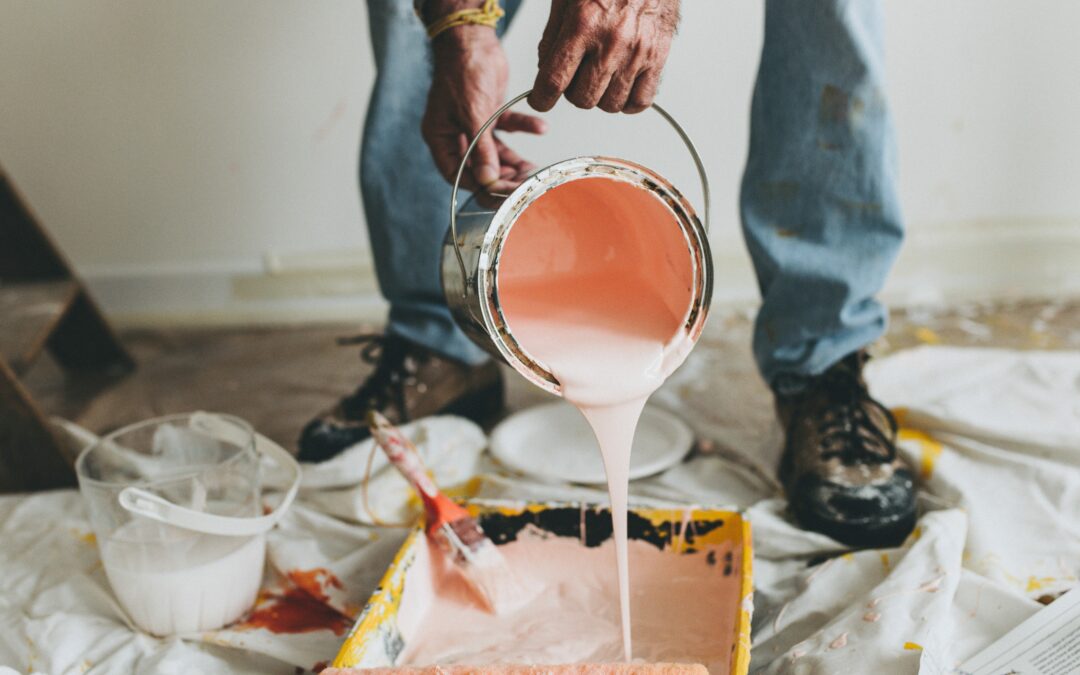Lead based paint was very common in houses that were built prior to the 1960s. Both interior and exterior paints produced between 1960-1990 may also contain lower levels of lead as well. All paints manufactured after 1992 should be virtually clear of lead but should also be inspected for assurance. When lead-based paint is in pristine condition it is safe to be around, but as soon as it is chipped it has become a danger to all. This is a problem because lead is a highly toxic metal that may cause serious health issues such as nervous system damage, kidney damage, and it also poses other long-term health risks, especially when exposed to children. Therefore, lead paint should always be maintained or removed from a home/building properly.
Painting Over Lead Based Paint
Yes, it’s probably much easier to paint over the existing coats of paint and be done with it. But, faster is not always better when it comes to your health. Safety should still be of the utmost importance when it comes to dealing with lead paint. One of the most significant factors when deciding whether it is safe to simply cover up lead paint by painting over it is the condition of the existing paint and wall. If they are both in good condition, then painting over them will form a barrier against the toxins in the lead paint.
Not any normal paint will safely cover lead-containing paint. To make sure that the paint, dust, and fumes are carefully controlled, a special type of paint known as an encapsulant must be used. It’s applied over the lead-based paint as a sealant to prevent paint chips or dust from being inhaled. Though DIY-ers can technically apply an encapsulant on their own, the safest and most recommended way of properly performing an on-site encapsulation is to hire an inspector to access the condition of the paint who will then guide you through the next steps like Ernst Home Inspections will.
If the wall or paint is in any way chipped,damaged, bubbling or peeling, then painting over it will not re-seal or protect you from the lead paint. The toxins contained underneath all the layers will still migrate through the topcoat, and therefore, will always be considered dangerous.
If you find yourself inside a building that was built prior to 1978 and the walls are in poor condition, then hiring a certified lead-paint removal team is important not only for the sake of the building’s integrity but also for the safety of everyone in the building
Issues with Lead-Based Paint
Lead-based paint may not damage your house, but most definitely can damage your health. Lead-based paint when exposed can cause life threatening health issues to you and your family. When lead-based paint is removed, repaired, or chipped on purpose or through normal wear-and-tear anyone who has absorbed lead into their bloodstream can be at serious risk. When lead-based paint is not chipped, removed, or repaired it will not put you in harms way, but that is only if there is not one single chip in the entire paint job. Chipping is very hard to avoid over time due to constant wear-and-tear from things like hanging pictures, moving furniture, and any type of touching of the walls, rails, windows, or doorways, etc.
Medical and scientific research shows that absorption of even very low levels of lead into the blood may have harmful health effects on your intellectual and behavioral development of infants and children. Pregnant mothers, children, and infants are the most at risk around lead-based paint. Fetuses, infants, and children’s development are at a huge risk when lead is absorbed. Lead ingestion or absorption can affect the child’s learning abilities and behavior due to the effects lead has on the brain. High levels of exposure can cause lead poisoning, anemia, and impaired brain and nervous system function. Currently there is no safe level of lead that can enter the body.
Some symptoms of High Levels of Lead Based Paint include:
- Headaches
- Irritability
- Loss of appetite
- Memory Loss
- Weakness
- Abdominal Pain
Symptoms of low-level exposure over a prolonged period of time include:
- Constipation
- Abdominal Pain
- Forgetfulness
- Nausea
- Depression
- Feeling Distracted
- Irritability
Identifying Danger Inside and Outside
Inside buildings, it’s typical to find the highest concentrations of lead paint in the older, oil-based paints that are commonly used on window sills, door trims, radiators, window panes, and other similar fixtures. Outside, lead is often found on doors, door trims, windows, railings, and fixed playground structures.
Given the wide array of possible lead contamination areas, you should know how to identify potential lead hazards, especially when chipping or cracking occurs at just the right height to be accessible to children. This is critical because lead paint has a sweet taste.
Inspection of Lead Paint
To ensure proper identification of lead hazards, you need to perform a lead-based paint inspection.When lead-based paint is found it must be professionally and properly dealt with as soon as possible since chipping can happen at anytime. This does not mean purchasing a lead paint kit at your local hardware store. Instead, to perform a thorough evaluation of your building and yard, you should obtain a multi-point inspection that, at a minimum, includes the following:
- Inspection for chalking, chipping, flaking, and peeling on all painted surfaces
- Lead-Based paint testing including: x-ray fluorescence to determine the exact location and quantity of lead paint
- Collection of lead paint samples (flakes, chips, or dust)
- Wiping of surfaces (especially outdoors) for the existence of lead dust
- Testing of all paint samples at an accredited testing facility
Final Words
Your home is viewed as your safe place, your nest, and your sanctuary away from the fast paced world that we live in today. Lead-based paint removes that feeling of safety within one’s home when it can cause so much damage to you and your family. When lead-based paint is found in the home it is just a ticking time bomb waiting to become chipped. It would be something you are always worried, anxious, and stressed about. Waiting.. And waiting to analyze it the next time to see a chip in the paint. This is why at Ernst Home Inspections we take time to analyze every painted surface with diligence to ensure your home is safe and hazard-free. We will take action, and come up with the safest plan to provide help if lead-based paint is found hiding within your home. Our goal is to give you back the feeling of safety within your own home.

